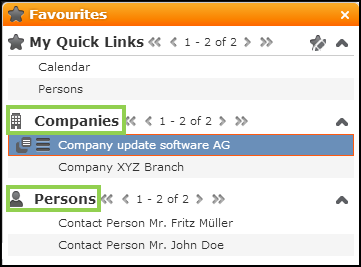Standard Headers
Find the list of standard headers in this topic.
Below is the list of standard headers:
Search/SearchLinked
Search pages displays the Search or SearchLinked header
at the top of the page.
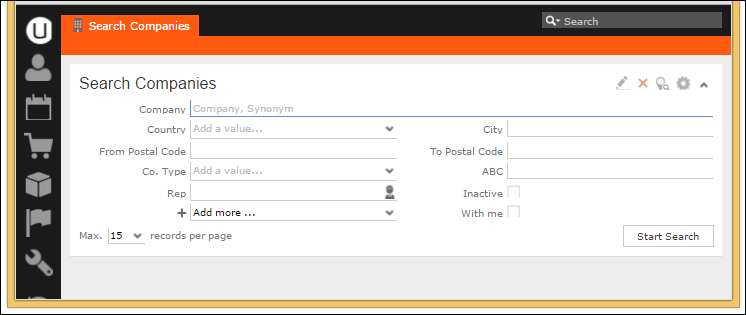
If a Search page is not linked to a record (e.g. the Company search
called from the application menu), the Search header is used.
The SearchLinked header is used for linked searches, i.e. a
link to parent record is defined in the Search action. For further details,
see link/linkId. Example: All
MA linked to the current FI in a Tree view:
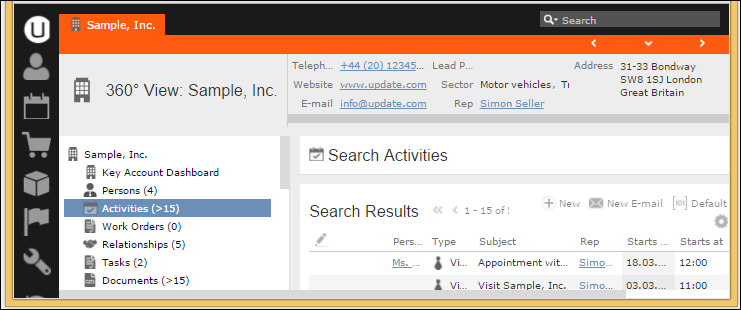
As you can define placeholders in the header text (see Header Attributes ), the definitions
of these headers are info area-independent, i.e. the Search and
SearchLinked headers from the DEFAULT header group can be used. For
further details, see DEFAULT Header Group.
SearchResults/SearchResultsLinked/SearchResultsSelect
The
SearchResults header is displayed between the search mask and the results
list. For linked searches, the SearchResultsLinked header is used, if
available.
Fallback: SearchResults
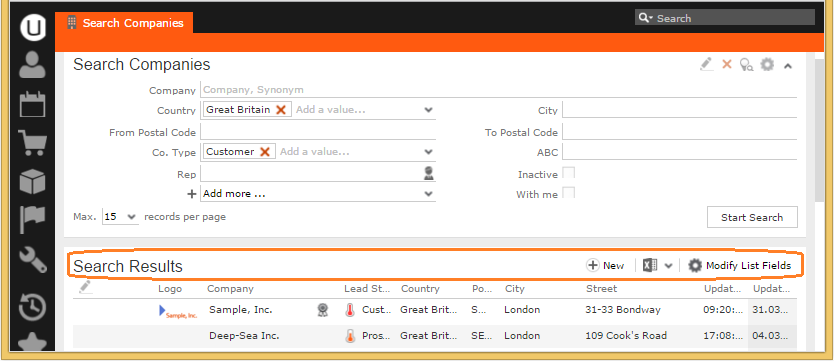
This header usually contains the text "Search Results" and allows users to
navigate within the result list. This header may also contain buttons. For further details,
see Header Buttons. If the
user clicks a button in the SearchResults header, the button's action is
executed on the record(s) selected in the list. The linked record (or parent record)
referenced in the action is the page's (optional) linked record. For a more detailed
explanation, see Defining an Action.
The SearchResults header contains a standard
New button to create a new record of the same type with the same
link (if a linked record exists). This button uses calls the ExpandNew
action with the infoAreaId parameter for the record's info area and the
link parameter as link for the new record. For further details, see Expand.
When using this standard
New button in the SearchResults header, you cannot
use that header for both a search started from the application menu and a search started
from a context menu for most info areas: Child info areas need a linked record, e.g. a
company or person, which is not available from the application menu. In this case you need
two different SearchResults headers: one for the action called from the
context menu containing the standard New button, and one when the
page is called from the application menu containing a New button
launching a process or not containing a button.
To implement two different headers,
either define two Search&List configurations or define an alternate
SearchResults header in the Search action.
Example
in UPDATE_DEFAULT: When creating a new activity (MA) from the application menu, the
SearchResults header of header group MA is used. The
New button in this header launches the
NewAppointment process, where the user has to select a parent record for
the activity.
When creating a new activity from a context menu (e.g. via
A_AllAppointments in M_Company), the
SearchResults header of header group MA-KP,FI is used.
This header contains the standard New button described
above.
If a Search action is called within a process and no special
SearchResults header is defined replacing the standard
SearchResults header, the SearchResultsSelect header is
used.
Example in UPDATE_DEFAULT: The SearchResultsSelect header in
header group KP contains two buttons: The WizardNew button
fires event 2, the WizardSearchViaCompany button fires event
3.
SearchSubList
The SearchSubList header is displayed below the search results list.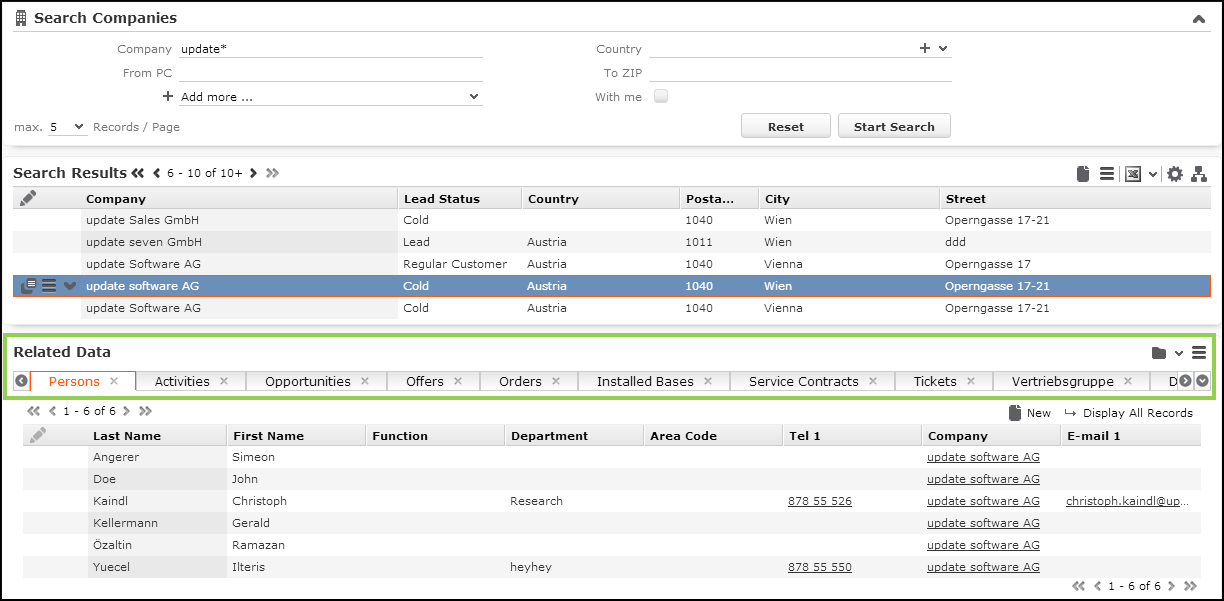
It controls which related data (e.g. linked info areas) is displayed when a record from the
search results list is select and how the sub-lists (i.e. records from child info areas) are
displayed. For further details, see Related Data area (Header Info Areas). The header text
and buttons for each sub-info area are defined per sub-info area in the corresponding
SubList headers. For further details, see SubList.
SubList
The SubList header defines the buttons available for sub-lists.

The layout of the sub-list rows is defined in the Infoareas section
of the SearchResults or ExpandChildren header of the
parent info area (Fieldgroup property). For further details, see
Related Data area (Header Info Areas).
New
The New header is displayed when creating new records. Expand action
template in New mode.
The default text is "New <Info Area>", e.g. "New Company".
A generic New header containing a Save
button is defined in the DEFAULT header group. For further details, see DEFAULT Header Group. The
New header has the Show buttons with text and
Show buttons in extra line check boxes checked: The buttons are
displayed in a separate line with the button text visible.
![]()
For some info areas a special New header with a Match-up
button is used instead. This calls the match-up function instead of simply saving the new
record. Examples in UPDATE_DEFAULT: FI, KP.
To include the linked record in the header text, you need separate New
headers for linked info areas. This is not defined in the UPDATE_DEFAULT configuration,
because the link is always displayed below the details control (Parent
Data). For further details, see ExpandOptions.
Expand
Expand pages display the Expand header at the top of the page.

ExpandChildren
The ExpandChildren header is displayed below the Expand view when
Related Data is selected.
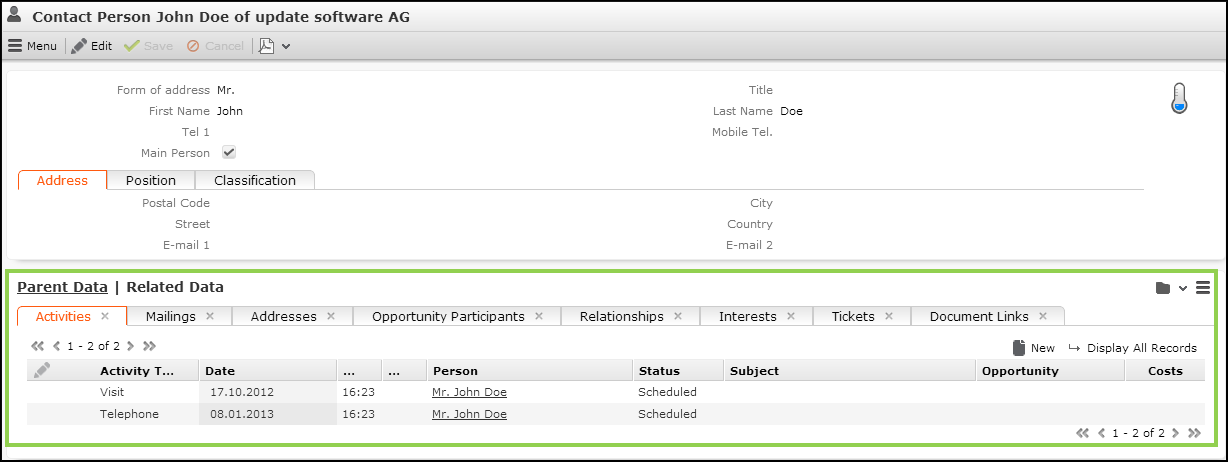
It controls which related data (e.g. linked info areas) is displayed and how
the sub-lists (i.e. records from child info areas) are displayed. For further details,
see Related Data area (Header Info Areas). The
header text and buttons for each sub-info area are defined per sub-info area in the
corresponding SubList headers. For further details, see SubList.
ExpandOptions
The ExpandOptions header defines the Related Data area below the details
mask, allowing the user to view related records in the lower half of the page. You can
display Parent Data, i.e. the parent links of the record and their
context menu, or Related Data containing available sub-lists. For
appointments the Participants area is available as well.
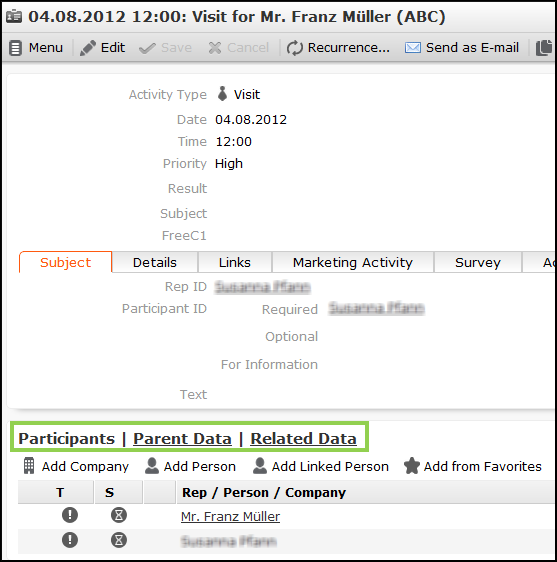
For information on configuring the ExpandOptions header,
see Header Links.
For information on configuring the buttons for the Participants area, see Participants Header (MA).
The parent records that are displayed in the Parent Data area is determined by the Expand configuration of the current record (View Parent Relations), see Expand Configuration.
Headers for TreeViews
At the top of a Tree page, the Tree header is displayed
similar to the Expand header of Expand pages.
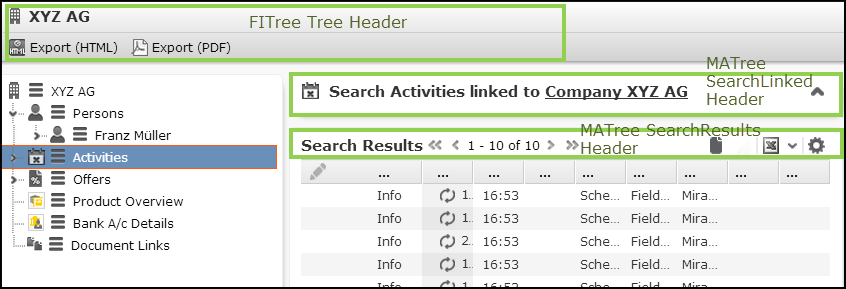
When clicking on an info area node in the tree, a Search view for this info
area is displayed using the SearchLinked and
SearchResultsLinked headers from the header group specified in the
corresponding Search&List configuration. For further details, see SearchResults/SearchResultsLinked/SearchResultsSelect and Info Area Settings. If no
SearchResultsLinked header is defined, the SearchResults
header is used as a fallback.
When clicking on an existing record in the tree, an Expand view with data of
that record is displayed using the Expand header from the header group
specified in the corresponding Expand configuration. For further details, see Expand and Record Settings.
When creating a new record from within the tree, the New
header from the header group specified in the corresponding Expand configuration is used.
For further details, see New and
NewCommand.
SimpleList
The SimpleList header is used for the section headers in the Favorites popup, in the Checked Out Documents popup list and as header of Most Recently Used lists on Process Ask pages.
The default text is "{INFOAREAIMAGE} {INFOS}".
